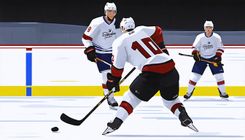NHL CBA Changes: New Development Path for Prospects

The current NHL collective bargaining agreement (CBA) is set to expire in September 2026. This timeline may evoke concern for those familiar with the league's history. However, in a noteworthy development, team owners and the NHL Players Association established the framework for a new agreement during the summer. While the complete Memorandum of Understanding for the new CBA has not yet been publicly released, NHL insider Frank Seravalli has highlighted a significant change: starting with the new CBA, each NHL team will be permitted to assign one 19-year-old prospect to their American Hockey League (AHL) roster each season.
This new policy will permit a total of up to 32 players per year to make this transition, a seemingly modest number that could result in profound changes to the development landscape for NHL prospects. Currently, under the CHL-NHL agreement, prospects drafted from Canadian major-junior leagues, specifically the Ontario Hockey League (OHL), Western Hockey League (WHL), or Quebec Major Junior Hockey League (QMJHL), are ineligible for AHL or ECHL assignments until they turn 20 or complete four seasons in the CHL. An exception exists for players drafted from other junior leagues who subsequently join a CHL team. The new CBA will not be enforced until the 2026-2027 season, meaning its impact will first be felt by players born in 2007. For instance, Vancouver Canucks prospect Braeden Cootes, who turns 19 in February 2026, could potentially be assigned to the Abbotsford Canucks that fall if the team believes it is no longer beneficial for his development to remain in the WHL.
The age-based rule rather than a draft-year stipulation means that a freshly drafted player from the CHL who turns 19 soon after being drafted could be assigned directly to the AHL. Taking 2026-eligible prospect Ryan Roobroeck as an example, as a September 2007 birthday, if Roobroeck signs his Entry-Level Contract (ELC) promptly and participates in his NHL team's development camp, there is a possibility for him to be directly assigned to the AHL, avoiding a return to the Niagara IceDogs of the OHL. This new development pathway may address a critical need for certain prospects. Historical cases, like that of Dylan Strome, illustrate the necessity for such options, as he was deemed too skilled for the OHL yet not prepared for the NHL, leading to developmental complications during his time with the Arizona Coyotes. The new framework could provide opportunities that prevent similar situations from occurring in the future.
Recent examples support this concept, as seen with Cole Perfetti's stint with the Manitoba Moose during the cancellation of his OHL season due to the pandemic. Similarly, Shane Wright received special permission to play with the AHL's Coachella Valley Firebirds during the 2023-2024 season after a lengthy OHL career that began when he was just 15. In both cases, participation in the AHL ultimately benefitted the players more than a return to junior or missing an entire season would have. According to insiders, this CBA amendment allows 'one player per organization per season,' implying that teams cannot shuffle several 19-year-old prospects back and forth to the AHL. It is unlikely that many teams will have multiple 19-year-old prospects simultaneously who require this kind of developmental opportunity. The new rule represents a boon for NHL teams aiming to closely monitor and develop their top prospects while also facilitating easier call-ups from the AHL roster.
Conversely, this change may challenge CHL teams. The one-player limit seems to have been influenced by the CHL's interests, as teams are likely to guard their most talented players against AHL assignments. While NHL teams can only assign one player, there is no stated limit on how many players can be taken from each CHL franchise. Such a situation could become precarious for top teams that produce elite prospects drafted by various NHL franchises. Additionally, the implementation of this new regulation aligns with shifts in the CHL to NCAA transfer rules. However, recent executive orders regarding NIL (name, image, likeness) regulations by US President Donald Trump may also alter the landscape, impacting prospects' decisions regarding college versus professional paths.
This development path grants elite CHL players an escape from the dilemma of being unprepared for the NHL while ineligible to return to junior leagues. They can now advance to professional hockey a year earlier, allowing them to refine their skills and gain meaningful experience instead of being benched in the NHL or dominating in junior leagues, where they may develop detrimental habits. One CHL team that could substantially benefit, albeit unwelcome to highlight, is the OHL's London Knights, consistently a powerhouse. Despite their success, players here may not face sufficient challenges to foster improvement. NHL executives may decide to promote top 19-year-old prospects from the Knights straight to the AHL to expedite their development.
This new regulation also harbors unforeseen benefits. According to Scott Wheeler, a prospect analyst for The Athletic, numerous agents have indicated that many players would opt for a CHL-to-AHL transition accompanied by ELC signing bonuses over enrolling in collegiate programs. A CHL general manager noted that, depending on the specific language of the CBA, players opting for the AHL at 19 might gain arbitration rights a year earlier, thereby increasing their bargaining power significantly. This unintended outcome is likely to be well-received by players and agents while posing challenges for NHL teams. Additionally, the signing bonus for players transitioning from CHL to AHL will further incentivize this choice, especially in light of the uncertainties surrounding NIL opportunities and the regulations governing foreign players in this context. The AHL not only guarantees a signing bonus but also provides a defined salary structure, allowing players to avoid returning to academia—something many prefer to sidestep.









